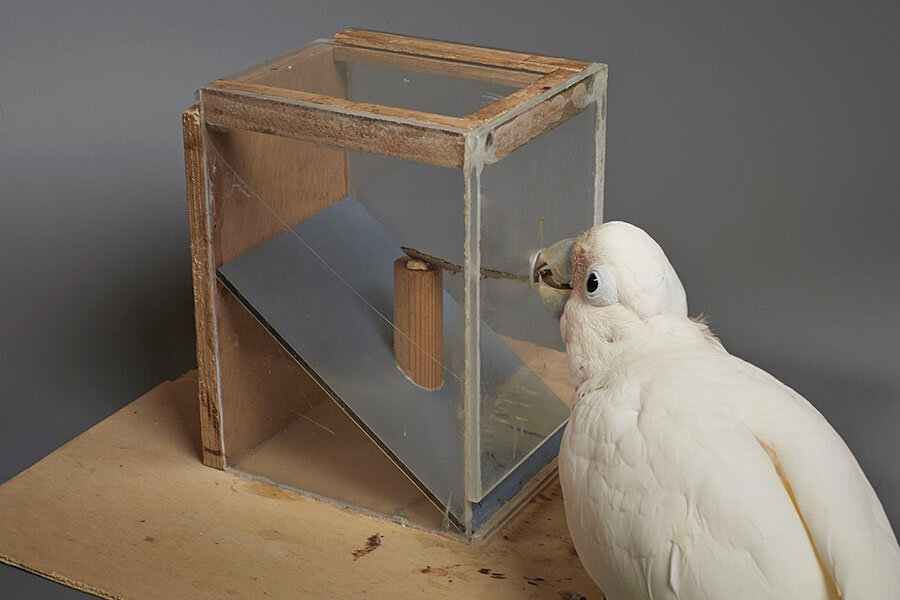For these clever tool-making cockatoos, the material might not matter
Loading...
To a cockatoo craving an out-of-reach snack, it might not matter what material is within reach to make a tool.
Scientists have observed one species, the Goffin's cockatoo, making tools from three different materials that worked the same way to accomplish the same task. They published their findings Tuesday in the journal Biology Letters.
"It demonstrates a degree of confidence, that the cockatoos know exactly what type of tool they need," Rob Shumaker, executive vice president and zoo director of the Indianapolis Zoo, and author of the book "Animal Tool Behavior," who wasn't part of the study, says in a phone interview with The Christian Science Monitor.
And perhaps this suggests the cockatoos are capable of a certain degree of foresight and innovation when it comes to manufacturing tools.
"Now it seems plausible that they can imagine which object would allow them to solve a new problem and go on to build it," study co-author Alex Kacelnik, a zoologist at the University of Oxford, said in a press release.
Tool-making was once thought to be a uniquely human ability, but evidence has mounted against the tale of "man the toolmaker." Other parrots, crows, and chimpanzees are among the other adept tool-users in the animal kingdom.
Goffin's cocktoos have not been seen using tools in the wild in their native Indonesia, nor do they employ similar skills to build nests. But a few individuals in captivity at the Messerli Research Institute at the University of Veterinary Medicine, Vienna have begun making a few tools.
One bird, named Figaro, spontaneously began breaking long splinters off of the wood of his cage, which he used to pull out-of-reach food morsels to him. Three others have since followed suit.
But the researchers weren't sure if that behavior was more one of convenience, as the fibrous nature of wood naturally creates the long, thin splinters perfect for such a foraging task. So they decided to test if the cockatoos would create the same kind of tools from other materials.
The scientists presented each bird with a foraging puzzle. A piece of food was placed within a transparent box, just out of reach from a small circular hole. But if the animal could find some way to knock the food off its pedestal, it would fall out of the bottom of the box.
The bird was presented with four different materials in separate trials: larch wood like what they had previously used to make tools, leafy beech twigs, a broad piece of cardboard, and a chunk of beeswax. None of the materials were the right shape to fish out the snack when the bird first encountered it.
"While none of the birds succeeded in making tools out of beeswax, we found that at least some of them could make suitable tools from the three remaining materials," Alice Auersperg, head of the Goffin Laboratory at the Messerli Research Institute, said in a press release.
To make a tool from the wood, a bird would bite at it until they could tear off a long splinter. With the twig, the bird snapped off leaves and side branches until what remained was the right size to fit in the hole to access the snack.
The cardboard, with no fibrous structure, was a little trickier. But the successful birds bit along the the edge of the cardboard like a hole punch, Dr. Auersperg explained, outlining an elongated piece of cardboard that they were then able to cut off of the rest of the material.
Once the bird had manufactured a long, thin tool from any of the materials, it adeptly stuck it in the box and knocked the snack free.
Dr. Shumaker, whose book "Animal Tool Behavior" outlines four different modes of tool-manufacture, says that although the birds use three different materials, this is really a display of just two modes: detach and subtract.
With the cardboard and wood, the cockatoos are detaching the tool from the raw material, he explains. But to shape the twig into a tool the birds subtract excess material, the side branches and leaves.
Still, Shumaker says, "when they can use two different modes of tool-manufacture for the exactly the same task, that demonstrates a degree of cognitive complexity that would not be there if they were limited to only one mode."
And this suggests that the birds "have a very genuine understanding of the task. The cockatoos understand the type of reaching tool that they need."
Because the birds are not known to use or manufacture tools in the wild, this ability and innovation suggests the birds are particularly cognitively flexible, Shumaker says. "What this reveals to me is the demands of their natural environment require them to have a level of flexibility in their cognitive skills that is not necessarily present in other species."
And they're doing all this with just their beaks, tongues, and claws. "There are only so many things you can do with a beak like that," Shumaker says. "It's a very hard, very powerful part of the body, and it has not nearly the range of abilities that a hand with an opposable thumb has." And yet, he says, the birds are able to accomplish something that requires a lot of finesse.









